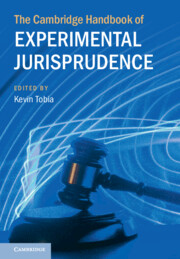Book contents
- The Cambridge Handbook of Experimental Jurisprudence
- The Cambridge Handbook of Experimental Jurisprudence
- Copyright page
- Contents
- Contributors
- Acknowledgments
- Dedication
- Part I Foundations and Theory
- Part II Introductions
- 11 Rules
- 12 Surveys and Experiments in Statutory Interpretation
- 13 Corpus Linguistics and Armchair Jurisprudence
- 14 Using Experiments to Inform the Regulation of Consumer Contracts
- 15 Experimental Jurisprudence of Health and Disability Law
- 16 Studying Public Perceptions of Settlement
- 17 Experimental Jurisprudence in International Law
- 18 The Law and Psychology of Gender Stereotyping
- 19 The Experimental Jurisprudence of Persistence through Time
- 20 Experimental Investigations of Judicial Decision-Making
- 21 Eye-Tracking as a Method for Legal Research
- 22 Intuitive Jurisprudence
- Part III Applications
- Index
- References
19 - The Experimental Jurisprudence of Persistence through Time
from Part II - Introductions
Published online by Cambridge University Press: 17 May 2025
- The Cambridge Handbook of Experimental Jurisprudence
- The Cambridge Handbook of Experimental Jurisprudence
- Copyright page
- Contents
- Contributors
- Acknowledgments
- Dedication
- Part I Foundations and Theory
- Part II Introductions
- 11 Rules
- 12 Surveys and Experiments in Statutory Interpretation
- 13 Corpus Linguistics and Armchair Jurisprudence
- 14 Using Experiments to Inform the Regulation of Consumer Contracts
- 15 Experimental Jurisprudence of Health and Disability Law
- 16 Studying Public Perceptions of Settlement
- 17 Experimental Jurisprudence in International Law
- 18 The Law and Psychology of Gender Stereotyping
- 19 The Experimental Jurisprudence of Persistence through Time
- 20 Experimental Investigations of Judicial Decision-Making
- 21 Eye-Tracking as a Method for Legal Research
- 22 Intuitive Jurisprudence
- Part III Applications
- Index
- References
Summary
Legal rights, obligations, and liabilities bind together entities, including people, real and moveable property, and abstract objects, across time. Determining whether these rights, obligations, and liabilities exist at any particular time therefore requires the law to embed within it a theory of persistence – that is, a theory of how entities persist over time. The philosophical and psychological literature has identified multiple different theories of how objects persist over time, some of which are identity relations and some of which are not. Research in experimental jurisprudence has shown both that ordinary people’s judgments about the law often match the content of the law itself and that ordinary people’s judgments appear sensitive to multiple different persistence relations. These findings provide reason to think that the law, to the extent it reflects the judgments of ordinary people, also reflects multiple different theories of persistence – contrary to recent arguments that legal rights depend solely on numerical identity.
Information
- Type
- Chapter
- Information
- The Cambridge Handbook of Experimental Jurisprudence , pp. 293 - 305Publisher: Cambridge University PressPrint publication year: 2025
